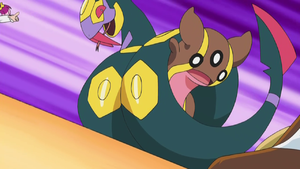Status condition: Difference between revisions
Phanpy1995 (talk | contribs) m (→Partially trapped: It's not a Cyndaquil anymore.) |
|||
| Line 135: | Line 135: | ||
===Followed=== | ===Followed=== | ||
If a Pokémon uses {{m|Follow Me}} or {{m|Rage Powder}}, it forces opposing Pokémon to target the user rather than the user's partner during [[Double | If a Pokémon uses {{m|Follow Me}} or {{m|Rage Powder}}, it forces opposing Pokémon to target the user rather than the user's partner during [[Double Battle]]s, as well as [[Triple Battle]]s, where it only effects adjacent targets. This is an increased priority move, and therefore will always go before attacks during the turn. | ||
If the user's partner is switching out, it will not divert an opponent from using {{m|Pursuit}} on its partner. It does not stop the effects of moves which hit multiple Pokémon in a battle. | If the user's partner is switching out, it will not divert an opponent from using {{m|Pursuit}} on its partner. It does not stop the effects of moves which hit multiple Pokémon in a battle. | ||
Revision as of 22:52, 19 May 2012
Status ailments affect a Pokémon's ability to battle. There are three kinds of status. The first are non-volatile, the second are volatile, and the third lasts while a Pokémon is in battle. The Pokérus is a similar but unrelated concept.
Non-volatile status
Non-volatile status ailments are status ailments that will remain until a Pokémon is healed at a Pokémon Center, a specific curative item is used, or, in case of Freeze and Sleep, after a certain amount of turns during the battle. A Pokémon inflicted with a non-volatile status will still be affected after being pulled out of battle (unless they have the Natural Cure ability), and after a battle is over. It is only possible for a Pokémon to be afflicted by one of these at a time. In Generation III and beyond, certain Abilities will cause or prevent them, as well as benefit from them.
Burn

- Main article: Burn (status ailment)
The burn condition (BRN) reduces a Pokémon's Attack power by half (except for Pokémon with the Guts ability, where this condition raises Attack by 50%). Additionally, at the end of a turn, the Pokémon loses 1/8 its maximum hit points (in Generation I or in the case of Pokémon with the ability Heatproof, the Pokémon loses 1/16 of its maximum hit points). Normally Template:Type2 Pokémon and Pokémon with the Water Veil ability cannot be burned; however, if a Pokémon is burned then has its type changed to Fire or its ability changed to Water Veil, the burn will remain. All moves which can cause burn are Fire-type except for Tri Attack (Generation II onwards), Fling when the Flame Orb is held, Scald and Ice Burn. In Generation V, Pokémon glow red when afflicted with burn.
Freeze

- Main article: Freeze (status ailment)
The freeze condition (FRZ) causes a Pokémon to be unable to make a move. Damaging Template:Type2 moves used on a frozen Pokémon will remove the freeze status. As of Generation II, freeze has a random, 20% chance to be cured on its own on the frozen Pokémon's turn. Consequently, the frozen Pokémon may thaw out on the turn of freezing; however, in Generation I, a frozen Pokémon never thaws without external aid. Pokémon cannot be frozen in sunny weather; contrary to popular belief, sunny weather does not cause a quicker thawing.
Template:Type2 Pokémon cannot be frozen by Ice-type moves; however, they can be frozen by Tri Attack and Secret Power. A frozen Pokémon can still use the moves Fusion Flare, Flame Wheel, Sacred Fire, Flare Blitz and Scald while frozen; these moves will thaw the user, thaw the opponent if possible, and deal damage to the opponent. All moves which cause freezing are Ice-type except Tri Attack (Generation II onwards) and Secret Power (when used in snow or ice; Generation IV only). It is also the only non-volatile status which has no move that causes it 100% of the time. The only move to provide more than a 10% chance of freezing is Secret Power when used on snow or ice, which provides a 30% chance. In Generation V, Pokémon glow blue and stop moving when afflicted with freeze.
A frozen Sky Forme Shaymin will revert to its Land Forme.
Paralysis

- Main article: Paralysis (status ailment)
The paralysis condition (PAR) causes a Pokémon to be unable to attack ("fully paralyzed") a quarter of the time. Additionally, its Speed is reduced to 25% of its previous value (except for Pokémon with the Quick Feet ability, where this condition raises the Speed by 50%). Many moves that cause paralysis are of the Electric type. Ground-type Pokémon can be paralyzed, but not by Electric-type moves or by the Battle Arcade. In Generation V, Pokémon glow yellow when afflicted with paralysis and their animation will be slowed significantly.
Poison

- Main article: Poison (status ailment)
The poison condition (PSN) causes a Pokémon to lose 1/8 of its maximum hit points every turn (in Generation I, it loses 1/16). Normally Steel- and Template:Type2 Pokémon and Pokémon with the Immunity ability cannot be poisoned; however, if a Pokémon is poisoned then has its type changed to Steel or Poison or its ability changed to Immunity, the poison will remain. In addition, in Generation II, Steel-type Pokémon can be poisoned by Twineedle.
A poisoned Pokémon also loses 1 hit point for every four steps taken while not in battle. In Generation IV, a Pokémon whose HP is reduced to 1 via poison outside of battle will have the poison status removed. As of Generation V, no HP is lost outside of battle, making it similar to a burn but without the attack reduction. All moves which can poison are of the Poison-type except Twineedle, Secret Power, and Fling (which poisons only if Poison Barb is held). In Generation V, Pokémon glow purple when afflicted with poison.
Bad poison
The badly poisoned condition is caused by Toxic and Poison Fang, as well as by Toxic Spikes after it is used twice. It is the same as Poison except its damage begins at 1/16 and grows an additional 1/16 every turn, taking 2/16 max hit points the second turn, then 3/16 the third turn, and 4/16 the fourth, and so on. In Generation I and Generation II, switching a Pokémon out of active battle would change the badly poisoned condition to normal poison. In Generation III and beyond, the "badly poisoned" effect will remain even after switching a Pokémon out of battle and back in, but the damage counter will be reset. After a battle is over, the "badly poisoned" status will become a normal poison. All moves which can badly poison are of the Poison-type except Fling (which badly poisons only if Toxic Orb is held). In Generation V, Pokémon glow purple when afflicted with bad poison.
Sleep

- Main article: Sleep (status ailment)
A Pokémon that is asleep (SLP) is immobilized and can only use the moves Snore and Sleep Talk.
Sleep lasts for a randomly chosen duration of 1 to 3 turns in Pokémon Black and White and Pokémon Stadium.[1] In all other games, except the Japanese versions of Pokémon Diamond and Pearl, sleep lasts 1 to 5 turns. In the Japanese version of Diamond and Pearl, the minimum and maximum sleep count is 1 turn higher, lasting 2 to 6 turns.[2] A Pokémon can inflict self-induced sleep using the move Rest, which will restore all of the Pokémon's health and remove any other non-volatile status ailment. A disobedient Pokémon may also nap during battle. There are, as of Generation V, eleven moves that cause sleep.
In Generation I, a Pokémon that wakes up is not able to attack that same turn, but since Generation II, it is able to attack as soon as the sleep wears off. In Generation V, a Pokémon's sleep counter is reset to its original amount when switched out; this also applies for self-induced sleep. Also in Generation V, Pokémon close their eyes while sleeping and they move slower as well.
Volatile status
A volatile status will wear off when a Pokémon is taken out of battle or a battle is over. Many of these will also wear off after a number of turns pass. All of these conditions may be passed to another Pokémon by using Baton Pass unless stated otherwise. Since they aren't shown in battle as a status aliment (having an icon) a Pokémon can be affected with multiple volatile ailments and a non-volatile aliment at the same time.
Confusion
The confused condition causes a Pokémon to hurt itself in its confusion 50% of the time. The damage is done as if the Pokémon attacked itself with a 40-power typeless physical attack.
Confusion wears off after 1-4 attacking turns. This means that turns recharging, such as after using Hyper Beam, and turns unable to attack, such as from paralysis, will not lower the remaining number of turns of confusion. However, a sleeping Pokémon may hurt itself in confusion if using a move such as Snore or Sleep Talk. Multi-turn attacks such as Fly and Dive require that confusion be checked both turns, further reducing the chance of successful attack.
Pokémon with the Own Tempo Ability are immune to being confused. Confusion can be cured with Persim Berries, the Yellow Flute, and items that cure all status ailments such as Full Heals and Lum Berries; it is the only volatile status ailment to be able to be cured by items that heal all status ailments.
Confusion is transferred by Baton Pass.
A Ninja Boy on Route 211 erroneously states that confusion only wears off if the Pokémon is switched out.
In the original series of the anime, Pokémon showed no physical difference when confused. They would often get dizzy and miss their attacks as opposed to attacking themselves. In the Advanced Generation series, Pokémon would get purple circles around their eyes as a sign of confusion and begin hurting themselves, or attacking their partner if in a Double Battle. In the Diamond & Pearl series, Pokémon's eyes become swirls and a circle of Torchic run around the confused Pokémon's head, with the confusion causing its attacks to miss. In the Best Wishes series, a Pokémon's eyes become stars and multiple stars spin around their head when they are confused.
Curse
If a Template:Type2 Pokémon uses Curse, the Pokémon it is used on loses ¼ of its maximum hit points every turn, and the user immediately loses half of their maximum hit points in exchange. A Pokémon afflicted by Curse cannot be healed except by switching out. If the victim of a Ghost-type Curse uses Baton Pass, the health-sapping effect is transferred to its replacement. Also, in Generation II, defeating the opponent will prevent the Pokémon it is used on taking damage from Curse on that turn.
Encore
Encore forces the Pokémon to repeat its last attack for 2-5 turns in Generation II, 4-8 turns in Generations III and IV, and 3 turns in Generation V. In Generation V, if the Pokémon has Magic Coat active, the move will fail.
Flinch

The flinch status is a one-turn status that prevents a Pokémon from attacking. A Pokémon can only flinch if the opponent attacks first. Pokémon with the Inner Focus ability are also immune to this. Most moves that cause flinching are physical moves. Pokémon with Steadfast still flinch, but gain Speed each time they do so.
It is known as cringing in Pokémon Mystery Dungeon.
Identify
The opponent's evasion modification will not affect the accuracy of a Pokémon that uses Foresight, Odor Sleuth, or Miracle Eye. In addition, a Normal- or Template:Type2 move used by a Pokémon that has used Foresight or Odor Sleuth will affect Template:Type2 Pokémon, and Template:Type2 moves used by a Pokémon that has used Miracle Eye will affect Template:Type2 Pokémon.
Infatuation
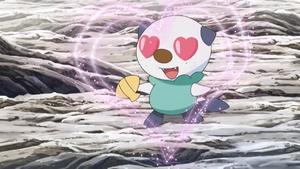
A Pokémon that is infatuated cannot attack 50% of the time, even against Pokémon other than the one it is infatuated with. It is caused when Attract is used on an opponent of the opposite gender, may be caused when a Pokémon makes contact with a Pokémon with Cute Charm of the opposite gender, and is caused to the target of the infatuation when a Pokémon holding a Destiny Knot is infatuated. Pokémon with the Oblivious Ability are immune to infatuation. Infatuation cannot be passed with Baton Pass. Infatuation will end as soon as either the affected Pokémon or the Pokémon it is attracted to is removed from the battle. It can also be removed by consuming a Mental Herb or playing a Red Flute.
In Pokémon Mystery Dungeon games, Infatuation prevents the Pokémon from doing anything for 5-6 turns, and causes linked moves to cease.
Nightmare
Nightmare only affects a sleeping Pokémon. The sleeping Pokémon loses ¼ of its maximum hit points every turn. If the sleeping Pokémon awakens, then the nightmare will no longer be in effect. If Baton Pass switches out a Pokémon that is not asleep, then the nightmare will no longer be in effect.
Partially trapped
When a Pokémon is hit by Magma Storm, Sand Tomb, Whirlpool, Wrap, Bind, Clamp, or Fire Spin, it becomes partially trapped. Until Generation V, this lasted 2-5 turns unless a Grip Claw was held; as of Generation V, partial trapping lasts 4-5 turns unless a Grip Claw is held. If the user of a partial trapping move is holding a Grip Claw, the move will last for 5 turns. A Pokémon can be affected by any number of partial trapping moves at a time.
Generation I
In Generation I, partial trapping moves inflict damage for 2-5 turns. There is a 37.5% chance that they will last 2 turns, a 37.5% chance that they will last 3 turns, a 12.5% chance that they will last 4 turns, and a 12.5% chance that they will last 5 turns. Though technically only the first attack can be a critical hit, every attack during the duration will do the same amount of damage. During this turn duration, the target will be unable to attack, and if the user of the move attacks before the target when used, the target will be unable to attack during that round as well.
Damage done by partial trapping move's continuing duration is done after recurrent damage. If the user switches out before the turn duration ends, the target will be unable to attack during that turn. If the target switches out before the turn duration ends, the partial trapping move will automatically be used against the incoming Pokémon, deducting an additional PP from the move. If at such a time the partial trapping move has 0 PP, it will still be used against the incoming Pokémon. After that use, the current PP of the move will roll over to 63, and full PP ups will be applied to it.
Even if the partial trapping move misses, it will negate the recharge turn normally required for Hyper Beam. Additionally, if the user of the partial trapping move attacks before the user of Hyper Beam during a recharge turn and the use of the partial trapping move misses, the user of Hyper Beam will automatically use Hyper Beam during that turn. If at such a time Hyper Beam has 0 PP, Hyper Beam will still be used, and afterwards its current PP will roll over to 63, and full PP ups will be applied to it.
In-game, the target will get to select a move during each turn of the partial trapping move's duration, and will attack the incoming Pokémon with the selected move if the player switches before the duration is over.
In Pokémon Stadium, it is possible to select a move during each turn of the partial trapping move's duration. If the target switches out before the duration ends, the incoming Pokémon will not automatically be attacked. The partial trapping move will negate the recharge turn of Hyper Beam only if successful.
In Generation II - IV
The target is now able to attack during a partial trapping move's duration, and can act normally. Instead, they inflict 1/16 of the target's maximum HP as damage for two to five turns upon use, in addition to the damage dealt when it is used. They also trap the target, preventing switching and escape. If a trapped Pokémon uses Rapid Spin, it will be freed.
If a wild Pokémon uses a partial trapping move on the player's Pokémon, the player may escape if the affected Pokémon has Run Away or is holding a Smoke Ball. However, these do not allow the player to switch the Pokémon out.
If the user of the partial trapping move is holding a Grip Claw, the duration will always be 5 turns. Also, if an affected Pokémon is holding a Shed Shell, it can switch out.
If the user of the partial trapping move switches out, the move's effects end.
Generation V
All partial trapping moves now last 4-5 turns unless a Grip Claw is held, which causes the moves to last 5 turns. The item Binding Band increases the damage dealt from 1/16 to 1/8 of the target's maximum HP while trapped.
Perish Song
After three turns, all Pokémon who heard the Perish Song will faint, excluding Pokémon with the Soundproof ability. Any Pokémon who heard it can avoid the effect of fainting if it is switched out before the 3-turn count finishes. Baton Pass transfers the Perish Song countdown.
Seeding

Seeding can only be caused by Leech Seed. Each turn, a seeded Pokémon loses 1/8 (1/16 in Generation I) of its maximum hit points. The opponent is healed by the same amount. Template:Type2 Pokémon are immune to Leech Seed. If a Pokémon affected by Leech Seed uses Baton Pass, Leech Seed is transferred to its replacement, even if it is a Grass-type. Even if the affected Pokémon switches out again within the battle, if sent out again, the effects still remain (unless Baton Passed again). If the user of Leech Seed switches out, the health granted by the effect is applied to the new replacement. There is no requirement for the Pokémon to use the move again, or even to know it. Unlike in the games, Leech Seed does not appear to restore the health of the Pokémon that used the attack.
Taunt
Taunt prevents the Pokémon from using any non-damaging moves. This effect will wear off after two to four turns, or if one switches out. Pokémon using Substitute can still be afflicted with this status ailment.
Torment
Torment renders the Pokémon incapable of using the same move twice in a row. If the Pokémon is holding a Choice item or only has one move remaining with PP, it is forced to use Struggle every second turn.
Volatile battle status
Defense Curl
Using Defense Curl causes the power of Rollout and Ice Ball to double for the Pokémon. This effect is not transferred by Baton Pass.
Focus Energy
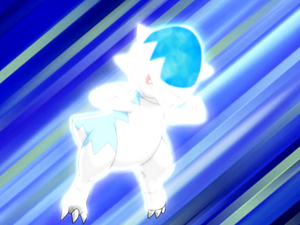
When a Pokémon uses Focus Energy, its critical hit rate quadruples.
Followed
If a Pokémon uses Follow Me or Rage Powder, it forces opposing Pokémon to target the user rather than the user's partner during Double Battles, as well as Triple Battles, where it only effects adjacent targets. This is an increased priority move, and therefore will always go before attacks during the turn.
If the user's partner is switching out, it will not divert an opponent from using Pursuit on its partner. It does not stop the effects of moves which hit multiple Pokémon in a battle.
Minimize
A Pokémon having used Minimize will take double damage if hit by the moves Steamroller or Stomp (though this behavior is not present in Generation I).
Mist
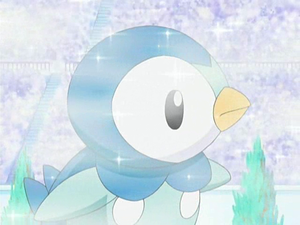
Mist prevents a Pokémon's stats from being lowered by the opponent's attacks. The user may still lower its own stats with moves like Superpower. The move Defog cancels out Mist.
Reflect and Light Screen
Reflect and Light Screen last for five turns (eight with Light Clay) and heighten the user's entire team's Defense or Special Defense, respectively. Either of them can be broken by Brick Break or Defog.
Safeguard
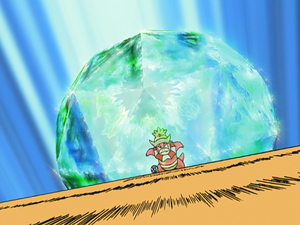
Safeguard prevents the user and its party from being affected by any status condition for five turns, except those caused by Abilities or held items and self-inflicted statuses. It also does not block the effect of Yawn if Yawn has already been used.
Substitute
The Pokémon that uses Substitute loses ¼ of its total HP (rounded down) to make a Substitute which will absorb hits until it "breaks" (damage the Substitute has taken is greater than the HP used to make it). From Generation II onward, Substitutes block all status ailments and will immediately break if a one-hit knockout attack connects with them. In Generation I, however, a substitute only blocks primary status ailments; attacks like Thunder Wave and Spore completely circumvent the Substitute. Substitutes can be transferred by Baton Pass.
Taking aim

When a Pokémon uses Mind Reader or Lock-On to take aim at a target, the next damage-dealing move will hit that target without fail, even if the opponent uses a move that offers a turn of invulnerability, such as Fly. This effect can be Baton Passed.
Trapped
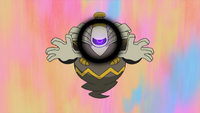
A Pokémon successfully trapped by Mean Look, Spider Web, Block, Shadow Hold, Shadow Tag, Arena Trap, or Magnet Pull cannot switch until the Pokémon that used the move is defeated or switches. The trapped Pokémon can escape if it is holding a Shed Shell; uses U-turn, Volt Switch, or Baton Pass; or is successfully hit with Whirlwind, Roar, Dragon Tail, or Circle Throw. Prior to Generation V, if a Pokémon trapped by a move uses Baton Pass, the Pokémon brought out will be trapped instead. The effects of moves that prevent ordinary switching is no longer passed in Generation V. Being trapped also prevents fleeing.
Trivia
- If a Pokémon under a status ailment (such as a poisoned Cascoon) evolves, the condition will be kept even if the Pokémon gains a new type or Ability that would normally prevent it.
References
| Status conditions | |||
|---|---|---|---|
| BURN | FREEZE | PARALYSIS | POISON |
| SLEEP | CONFUSION | FLINCH | FAINTING |

|
This game mechanic article is part of Project Games, a Bulbapedia project that aims to write comprehensive articles on the Pokémon games. |
